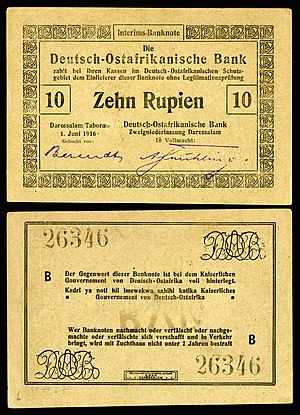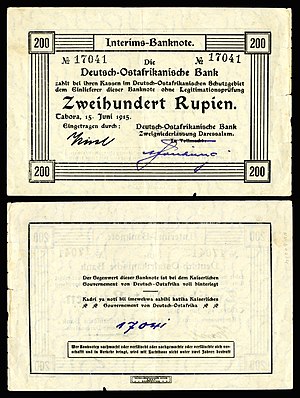Loading AI tools
| This article is rated Start-class on Wikipedia's content assessment scale. It is of interest to the following WikiProjects: | ||||||||||||||||||||||||||||||||||||||||
| ||||||||||||||||||||||||||||||||||||||||
Hello! This is to let editors know that the featured picture File:GEA-9Ab-Deutsch Ostafrikanische Bank-1 Rupie (1915).jpg, which is used in this article, has been selected as the English Wikipedia's picture of the day (POTD) for May 13, 2021. A preview of the POTD is displayed below and can be edited at Template:POTD/2021-05-13. For the greater benefit of readers, any potential improvements or maintenance that could benefit the quality of this article should be done before its scheduled appearance on the Main Page. If you have any concerns, please place a message at Wikipedia talk:Picture of the day. Thank you! Cwmhiraeth (talk) 12:59, 1 May 2021 (UTC)
 |
The rupie was the unit of currency of German East Africa between 1890 and 1916. During World War I, the colony was cut off from Germany as a result of a wartime blockade and the colonial government needed to create an emergency issue of banknotes. Paper made from linen or jute was initially used, but because of wartime shortages, the notes were later printed on commercial paper in a variety of colours, wrapping paper, and in one instance, wallpaper. This one-rupie banknote was issued in 1915, and is now part of the National Numismatic Collection at the Smithsonian Institution. Banknote design credit: Deutsch-Ostafrikanische Bank; photographed by Andrew Shiva
Recently featured:
|
 |
The rupie was the unit of currency of German East Africa between 1890 and 1916. During World War I, the colony was cut off from Germany as a result of a wartime blockade and the colonial government needed to create an emergency issue of banknotes. Paper made from linen or jute was initially used, but because of wartime shortages, the notes were later printed on commercial paper in a variety of colours, wrapping paper, and in one instance, wallpaper. This five-rupie banknote was issued in 1915, and is now part of the National Numismatic Collection at the Smithsonian Institution. Banknote design credit: Deutsch-Ostafrikanische Bank; photographed by Andrew Shiva
Recently featured:
|
 |
The rupie was the unit of currency of German East Africa between 1890 and 1916. During World War I, the colony was cut off from Germany as a result of a wartime blockade and the colonial government needed to create an emergency issue of banknotes. Paper made from linen or jute was initially used, but because of wartime shortages, the notes were later printed on commercial paper in a variety of colours, wrapping paper, and in one instance, wallpaper. This ten-rupie banknote was issued in 1916, and is now part of the National Numismatic Collection at the Smithsonian Institution. Banknote design credit: Deutsch-Ostafrikanische Bank; photographed by Andrew Shiva
Recently featured:
|
 |
The rupie was the unit of currency of German East Africa between 1890 and 1916. During World War I, the colony was cut off from Germany as a result of a wartime blockade and the colonial government needed to create an emergency issue of banknotes. Paper made from linen or jute was initially used, but because of wartime shortages, the notes were later printed on commercial paper in a variety of colours, wrapping paper, and in one instance, wallpaper. This twenty-rupie banknote was issued in 1915, and is now part of the National Numismatic Collection at the Smithsonian Institution. Banknote design credit: Deutsch-Ostafrikanische Bank; photographed by Andrew Shiva
Recently featured:
|
 |
The rupie was the unit of currency of German East Africa between 1890 and 1916. During World War I, the colony was cut off from Germany as a result of a wartime blockade and the colonial government needed to create an emergency issue of banknotes. Paper made from linen or jute was initially used, but because of wartime shortages, the notes were later printed on commercial paper in a variety of colours, wrapping paper, and in one instance, wallpaper. This fifty-rupie banknote was issued in 1915, and is now part of the National Numismatic Collection at the Smithsonian Institution. Banknote design credit: Deutsch-Ostafrikanische Bank; photographed by Andrew Shiva
Recently featured:
|
 |
The rupie was the unit of currency of German East Africa between 1890 and 1916. During World War I, the colony was cut off from Germany as a result of a wartime blockade and the colonial government needed to create an emergency issue of banknotes. Paper made from linen or jute was initially used, but because of wartime shortages, the notes were later printed on commercial paper in a variety of colours, wrapping paper, and in one instance, wallpaper. This two hundred rupie banknote was issued in 1915, and is now part of the National Numismatic Collection at the Smithsonian Institution. Banknote design credit: Deutsch-Ostafrikanische Bank; photographed by Andrew Shiva
Recently featured:
|
Wikiwand in your browser!
Seamless Wikipedia browsing. On steroids.
Every time you click a link to Wikipedia, Wiktionary or Wikiquote in your browser's search results, it will show the modern Wikiwand interface.
Wikiwand extension is a five stars, simple, with minimum permission required to keep your browsing private, safe and transparent.




